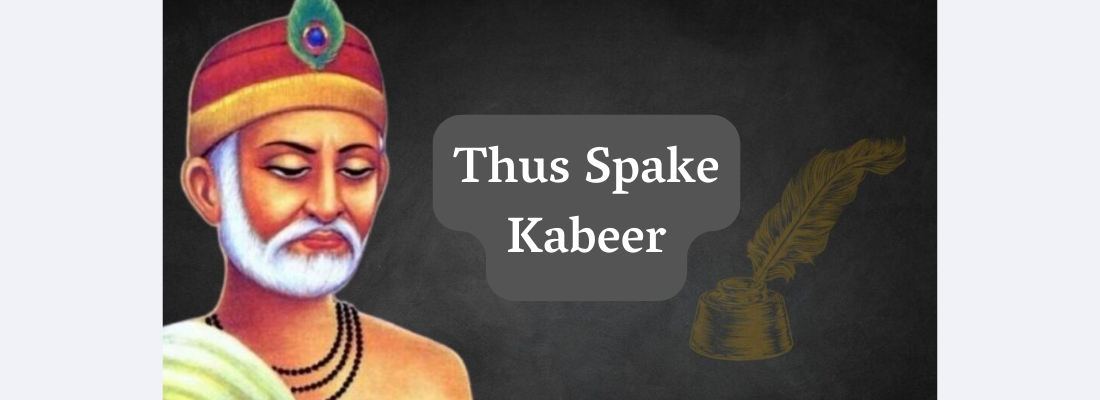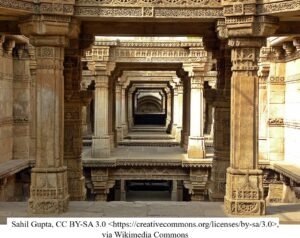Kabeerdaas ji is categorized as a saint but his thoughts and compositions are not confined to religion, spirituality, meditation and bhajans alone. He also deals with worldly life – the character and behaviour of individuals; practices (and malpractices) rampant in society; evils of caste system which divides people into ‘high’ and ‘low’ classes, etc. He also goes in depth in denouncing superstitions and hypocrisy prevalent in practice of religions and sects in general. He considers them as obstructions in the way of health, peace and happiness of society. We should take all these things into account if we want to understand and interpret Kabeerdaas ji’s poetry correctly.
— Kusum Banthia
सब ही भूमि बनारसी, सब निर गंगा होय ।
ज्ञानी आतम राम है, जो निरमल घट होय ।।
Sab hii Bhoomi Banaarasi, sab nir Gangaa hoy
Gyaanii aatam Raam hai, jo nirmal ghat hoy
For Kabeerdaas ji, religion was a matter of a matter of heart and soul, not of rites and rituals. He was staunchly opposed to these showy manifestations of different religions which, to him, were mindless exercises without soul. He believes individual soul to be the abode of Brahman, the Supreme Being. This realization comes to a person who has cleansed his heart and soul through deep devotion, spiritual practice and meditation. Once he is enlightened, he sees the presence of the Divine everywhere. To him the earth everywhere is holy like the holy city of Banaaras (Kaashee, Varanasi), all water is holy like water of River Gangaa and every soul is Brahman Himself.
.

जीवन में मरना भला, जो मरि जाने कोय ।
मरना पहिले जो मरै, अजर अमर सो होय ।।
Jeevan men maranaa bhalaa, jo mari jaane koy,
Maranaa pahile jo marai, ajar amar so hoy
The literal meaning of this couplet is that he who knows how to die should better die. Such a person never ages nor does he die. This creates a strange visualisation in the mind. To understand this, we must first know Kabirdaas ji’a alternative concept of death. In this concept, two types of “death” have been described – first, which we are all aware of, physical death, in which the heart of a person stops beating, the body becomes lifeless and consciousness ends. In this case, the life, relationships and conditions of this world have no effect on him. In Kabirdaas ji’s second hypothesis of dying, even in the living state, a man is not affected by the conditions and relationships of the world, if he can achieve stability of the mind through asceticism. To him, this world made of illusion, is as meaningless as it would be for a dead person.
In the first line of this couplet, Kabeerdaas ji says that if one knows the right way to die – to remain unaffected by the illusion of the world even while alive, then he should die.
In the second line of the couplet, he explains the reason for his statement and says that the person who dies in this way, becomes free from the attachment of the world, his soul attains salvation after the death (physical) and merges with Brahman. His cycle of birth-age-death on this earth, comes to an end.

-
Thus Spake Kabeer 01
Kabeerdaas ji is categorized as a saint but his thoughts and compositions are not confined to religion, spirituality, meditation and bhajans alone. He also deals with worldly life – the character and behaviour of individuals; practices (and malpractices) rampant in society; evils of caste system which divides people into ‘high’ and ‘low’ classes, etc. He…
-
Thus Spake Kabeer 02
Kabeerdaas ji is categorized as a saint but his thoughts and compositions are not confined to religion, spirituality, meditation and bhajans alone. He also deals with worldly life – the character and behaviour of individuals; practices (and malpractices) rampant in society; evils of caste system which divides people into ‘high’ and ‘low’ classes, etc. He…
-
Thus Spake Kabeer 03
Kabeerdaas ji is categorized as a saint but his thoughts and compositions are not confined to religion, spirituality, meditation and bhajans alone. He also deals with worldly life – the character and behaviour of individuals; practices (and malpractices) rampant in society; evils of caste system which divides people into ‘high’ and ‘low’ classes, etc. He…


